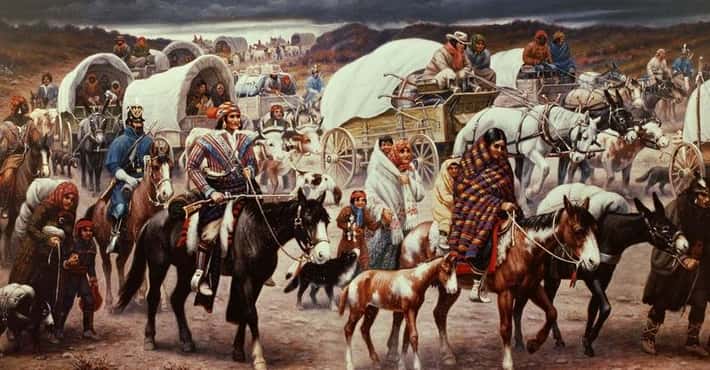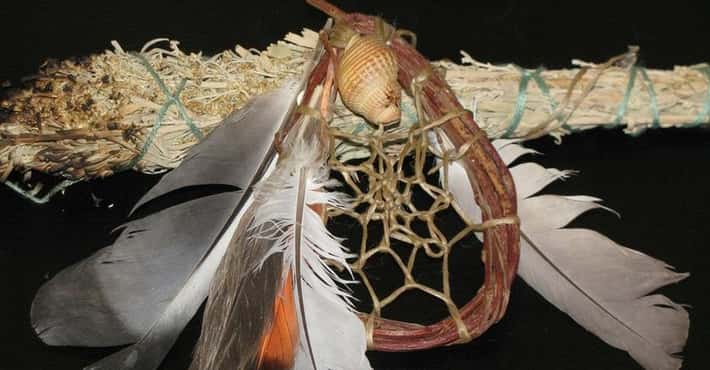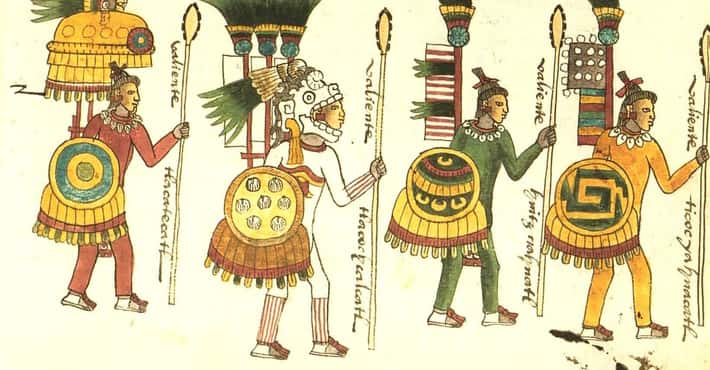The Life And Legacy Of Jim Thorpe
- Photo: National Archives and Records Administration / Wikimedia Commons / Public Domain
Jim Thorpe Was A Member Of The Sac And Fox Nation, And He Started Playing Baseball In Primary School
James Francis Thorpe was born in what is now Oklahoma in 1888 (some sources list it as 1887). At the time of his birth, Prague was in Indian Territory where Thorpe's father, Hiram, and his mother, Charlotte, lived in a small cabin. Hiram was of Irish, as well as Sac and Fox Native American descent while Charlotte was part Potawatomi and French.
When Thorpe was born, his mother reportedly gave him an additional name in accordance with Potawatomi custom. She called him Wathohuck, which means "bright path."
Thorpe had a twin brother Charles, and the two attended school at the Sac and Fox Indian Agency School in Oklahoma, much to the dismay of the former. Thorpe was restless, preferring "forest lore... to hunt and fish... to wait beside a runway and stalk a deer..." He eventually found baseball, however, making school somewhat more tolerable.
Charlie, whose Potawatomi name is unknown, suffered spinal meningitis and passed at 8 years old, prompting Thorpe to leave school. When Thorpe returned home, his father made plans to send him to an institution further from home - one that Thorpe couldn't run away from as easily - ultimately enrolling him at Haskell Indian Junior College in Lawrence, KS, in 1898.
- Photo: Carlisle Indian Industrial School / Wikimedia Commons / Public Domain
Thorpe Distinguished Himself As An All-American Athlete As A Teenager, Even After Dropping Out Of School For A Time
Haskell Indian Nations University, as it is now known, opened its doors in 1884 and was located about 300 miles from Thorpe's family home. When Hiram sent his son to Haskell, the institution was known for its discipline, and Thorpe had his hair cut very short, was dressed in a uniform, and told to follow the rules.
During his time at Haskell, Thorpe was said to be "very conscientious about his appearance. He was very proud of his uniform and took great pains to keep his brass buttons polished and his shoes, the first real pair he'd ever owned, shined." Thorpe underwent hours of instruction each day, as well as watched the football team from the sidelines, mimicking their movements and learning about the game.
When his father was hit in a hunting mishap, the future Olympian was said to have walked all the way home, leaving school against the wishes of his family and administrators. After a brief time at home where his father recovered, Thorpe headed for Texas where he worked as a ranch hand. He soon returned home, only to say a final goodbye to his mother, who succumbed to blood toxicity.
Thorpe and his older brother, George, looked after their siblings and worked the land he'd been allotted after his mother perished. He also attended Garden Grove public school near home where, on May 12, 1904, he was visited by a representative from Carlisle Indian Industrial School in Carlisle, PA. At the time, Carlisle was among the most successful non-reservation boarding schools for Native American children in the nation. It was also where coach Glenn "Pop" Warner was poised to build a football dynasty.
Thorpe arrived at Carlisle in June 1904, then attended for less than a year before he went to work doing odd jobs as a farm foreman, returning to school in 1907. Only 19 at the time and still somewhat small at 5'9½'' and less than 150 lbs, he had yet to impress Warner with his athletic ability. Thorpe recalled how he finally got the coach's attention:
Late one afternoon in the spring of 1907, I was among a group of tenderfoot football players crossing the upper track deck on our way to the lower field where we would play a twilight game with one of the scrub teams on campus. I happened to notice that some of the members of the varsity were practicing the high jump... After a while they had the bar at [5'9"] and none of them could jump over it... I had a pair of overalls on, a hickory shirt, and a pair of gymnasium shoes I had picked up in the gym that belonged to someone... The track athletes snickered as the bar was set for me. I cleared it on my first try and, laughing at the astonished group of athletes, went on down to the lower field for the game.
Word of Thorpe's jump got out and, when Warner saw Thorpe the next day, he told him, "Boy, you've just broken the school record!"
Thorpe was immediately given a track uniform and taken under Warner's wing. In addition to being on the track team, Thorpe played football for Warner, earning a spot on Walter Camp's All-American Team in 1911 and 1912.
- Photo: Unknown / Wikimedia Commons / Public Domain
Thorpe Won Gold Medals For The Pentathlon And The Decathlon At The 1912 Olympics
Thorpe's talent put Coach Pop Warner in a difficult position. As coach of both the track and football teams at Carlisle, Warner struggled with putting Thorpe on the football field, leaving him exposed to possible fractures. Thorpe had broken nearly every track and field record at Carlisle, dominated at events like Penn Relays, and won multiple events at track meets against powerhouse schools like Syracuse. At the Middle Atlantic Association Meet, Thorpe competed in his specialties: "the 100-yard dash, the 120- and 220-yard hurdles, the broad and high jump... [and] could also throw the hammer and [shotput] with the best."
In anticipation of the 1912 Olympic games, three trials were held - one at Stanford, CA; another in Evanston, IL; and a third in Cambridge, MA. Thorpe competed at Cambridge, making the Olympic team in two individual events, as well as the pentathlon and the decathlon.
Once Thorpe got to Stockholm, Sweden, (there are contradictory reports as to whether or not Thorpe refused to train while aboard the SS Finland on his way to the games), the location of the 1912 Games, he placed fourth in the running high jump, seventh in the running long jump, but dominated during the multi-events. Despite a slow start during the decathlon, Thorpe won the high jump and 110-meter hurdles. He placed at the top in all of the other events, including the javelin, an event he'd only been participating in for a few months. By the time the decathlon was over, Thorpe had earned 688 points more than his closest competitor, Hugo Wieslander from Sweden.
Thorpe also scored a nearly perfect performance in the pentathlon with seven points.
- Photo: IOC/Olympic Museum Collections / Wikimedia Commons / Public Domain
He May Have Been Called The 'Greatest Athlete In The World' By The King Of Sweden
When Thorpe was presented with his gold medal for the pentathlon, King Gustav of Sweden did the honors, placing a laurel wreath on the champion's head. King Gustav, once again, presented Thorpe with his wreath and medal during the ceremony for the decathlon, this time reportedly telling Thorpe, "Sir, you're the greatest athlete in the world!"
Thorpe simply replied, "Thanks, King."
After the Olympics, Thorpe and his teammate, Lewis Tewanima, visited several European cities to participate in exhibition events. Both of Native American heritage, Thorpe and Tewanima had competed together at Carlisle, where the latter distinguished himself as a distance runner. Tewanima was a Hopi Indian who also participated in the 1908 Olympics and, when Thorpe and Tewanima returned to the United States, they were honored with a tickertape parade in New York City.
Thorpe embraced the attention, telling reporters, "The fact that I was able to represent America in such a great thing as an Olympic meet will always be one of the things to which I shall point with pride in my life." Tewanima was much more hesitant to speak in a public forum, prompting Thorpe to assert, "And I believe that everything I say I voice the sentiments of my teammate, Tewanima, here."
- Photo: Unattributed / Wikimedia Commons / Public Domain
Thorpe Lost His Olympic Medals Because He Broke Rules About Amateur Participation
Within months of earning his gold medals, Thorpe found himself embroiled in controversy. Roy Johnson, a reporter for the Worcester Telegram, wrote a story outing Thorpe as a former professional baseball player. At the heart of the story was Charles Clancy, a baseball coach from North Carolina, who claimed that Thorpe had played for him in 1909 and 1910.
Confusion over whether or not Thorpe had played professional baseball - something that disqualified him from amateur status - put his college and Olympic performances in the spotlight. Thorpe took the accusations head on, sending a letter to James Sullivan, commissioner of the American Olympic Committee:
I played baseball at Rocky Mount and at Fayetteville, NC, in the summer of 1909 and 1910 under my own name. On the same teams I played were several college men from the north who were earning money by ball playing during their vacations and who were regarded as amateurs at home. I did not play for the money there was in it because my property brings me in enough money to live on, but because I liked to play ball. I was not wise in the ways of the world and did not realize this was wrong, and that it would make me a professional in track sports, although I learned from the other players that it would be better for me not to let anyone know that I was playing and for that reason I never told anyone at the school about it until today.
In the fall of 1911 I applied for readmission to this school and came back to continue my studies and take part in the school sports and of course I wanted to get on the Olympic team and take a trip to Stockholm. I had Mr. [Pop] Warner send my application for registering in the AAU [Amateur Athletic Union]... I received my card allowing me to compete on the winter meets and other track sports. I never realized until now what a big mistake I made by keeping it a secret about my ball playing and I am sorry I did so.
Thorpe was contrite but openly confessed to taking money in exchange for play. In response, the AAU asserted it would "do everything in its power to secure the return of prizes and readjustment of points won by him, and will immediately eliminate his records from the books."
Thorpe was stripped of his Olympic gold medals for both the decathlon and the pentathlon. Despite reports that runners-up Hugo Wieslander (decathlon) and Ferdinand Bie (pentathlon) declined the medals, they did accept them, although they insisted they'd return them to Thorpe if instructed to do so.
- Photo: Unknown / Wikimedia Commons / Public Domain
Thorpe Played Professional Baseball For Six Seasons
As the controversy surrounding his athletic status unfolded, Thorpe received international attention. Once it was decided he was no longer an amateur, Thorpe had to leave Carlisle, but received offers to become a professional boxer, an entertainer, and even an actor. He was also approached by six professional baseball teams, all interested in the talented free agent.
Thorpe signed with the New York Giants, earning $4,500 for each season of his three-season contract (other sources report the pay was as high as $6,000 per season). Manager John McGraw reportedly knew very little about Thorpe - including whether he was left- or right-handed - but still paid him the highest salary ever earned by a rookie in the league.
Thorpe played for the New York Giants from 1913 to 1915, for the Cincinnati Reds in 1917, again with the Giants from 1917 to 1919, and finally with the Boston Braves in 1919. Most often positioned in the outfield, Thorpe occasionally pitched as well. He played a total of 289 games and 176 hits with a batting average of .252 over his career.
- Photo: Unattributed / Wikimedia Commons / Public Domain
During His Professional Football Career, He Excelled As A Member Of The Canton Bulldogs
In addition to his time on the baseball field, Thorpe played for the Canton Bulldogs of the Ohio Football League as early as 1915. He remained on their roster during the team's "world champion" seasons in 1916, 1917, and 1919. Thorpe's presence on the football field helped bring in large crowds for the Bulldogs and brought more attention to Ohio football in general.
Thorpe, the team's de facto leader, was recognized as one of the best players in the sport. According to former teammate Pete "Fats" Henry, Thorpe "crashed through, flattening everything in site."
He wasn't a poor sport, however, "unless someone [disrespected] him first. Then he'd spend the rest of the game getting even," in the words of Bulldog manager, Jack Cusack.
- Photo: Goudey / Wikimedia Commons / Public Domain
He Helped Organize The American Professional Football Association, The Predecessor To The National Football League
Thorpe wasn't just a player in the newly formed American Professional Football Conference (APFC) - he was also the organization's inaugural president, unanimously elected by his peers.
Thorpe was one of seven men who organized the league in 1920, which initially included 11 teams from four states. The APFC was intended to address issues related to payment, team membership, and whether or not to allow college players to join rosters.
The APFC expanded quickly with four new teams joining during its first year. Thorpe served as the APFC's first president but only headed the group for one year. In 1921, Thorpe started a new team called the Oorang Indians.
The Oorang Indians were based in LaRue, OH, but played in nearby Marion. Sponsored by kennel owner Walter Lingo, their roster featured Thorpe, who was their biggest draw, but also included tribal names like Little Twig, War Eagle, and Long Time Sleep. At half time, dog shows and Native American ceremonial dances entertained spectators. The Oorang Indians stopped playing in 1923 with just three wins.
- Photo: Revmoran / Wikimedia Commons / Public Domain
Thorpe Played On A Traveling Native American Basketball Team
Between 1920 and 1928, Thorpe played for several professional football teams, including the Rock Island Independents and the New York Giants. He returned to the Canton Bulldogs in 1926 but was a member of the Chicago Cardinals when he announced his retirement from sports in 1928.
During his final years playing football, however, Thorpe again demonstrated his athletic ability by playing two sports, adding basketball to his resume. From 1927 to 1928, Thorpe "and his world famous Indians" played basketball in New York, Ohio, and Pennsylvania.
- Photo: Harris & Ewing / Wikimedia Commons / Public Domain
Once He Retired From Sports, Thorpe Worked As An Actor And Took On Numerous Odd Jobs To Support His Family
Thorpe married for the first time in 1913, to Iva Miller. They had a son named James Jr., who perished of polio in 1917, and three daughters, Gale, Charlotte, and Francis. After divorcing Miller in 1924, Thorpe married Freeda Kirkpatrick the following year. With Kirkpatrick, Thorpe had four more children, sons Phillip, William, Richard, and John. Thorpe agreed to pay his first wife, Miller, alimony and child care expenses, but by 1928, was, reportedly, "very dilatory" in his payments.
After leaving sports, Thorpe moved his family to California where he worked as an actor. He played Native Americans, often arranging for his wife, Kirkpatrick, and his sons to have small roles as well. He appeared in Battling with Buffalo Bill in 1931 but worked on an excavation crew in Los Angeles as well. Too poor to buy a ticket for the 1932 Olympic Games in 1932, Thorpe was invited to attend by Vice President Charles Curtis. Just a few short months later, he was trying to make ends meet by taking small film roles and participating in various speaking engagements. Thorpe reportedly worked as a painter, a ditch digger, and even joined the Merchant Marines for a time during the 1940s.
During the 1930s, he became involved in Native American politics, participating in a campaign to eliminate the Bureau of Indian Affairs. He also struggled with drinking, and is said to have vacillated between long periods of abstinence and overindulgence.
Thorpe sold the rights to his life story to MGM in 1929 for a project that never came to fruition. In 1951, Burt Lancaster played Thorpe in the aptly named motion picture Jim Thorpe - All American, something that brought the athlete a new round of media attention.
- Photo: Doug Kerr / Wikimedia Commons / CC BY-SA 2.0
Thorpe's Wife Had His Remains Taken To Pennsylvania Where They Were Buried In A Town Named After Him
Thorpe was named the "best male athlete of the half century" by the Associated Press in 1950 and a statue was built in his honor in Pennsylvania. Thorpe, now married for a third time to Patricia Askew, experienced two cardiac episodes, one in 1942 and another in 1952, before succumbing to heart failure in 1953. Thorpe passed on March 28.
Thorpe was initially taken to Shawnee, OK, to be laid to rest in accordance with traditional Sac and Fox custom. His wife was said to have had little regard for Native American tradition, arriving at the family plot with police and demanding her husband's remains. Askew sought financial compensation for where to place Thorpe after funding for a monument to him in Oklahoma fell through, approaching the NFL and locations near Carlisle Indian School. She sent Thorpe to Pennsylvania where the recently merged towns of Mauch Chunk and East Mauch Chunk had agreed to change their name to Jim Thorpe, PA.
Jim Thorpe, PA, built a monument to the famed athlete, one that featured red stone with etchings of Thorpe playing football, baseball, and participating in track and field events. The words of King Gustav of Sweden, "You, Sir, are the greatest athlete in the world," were also included, and there is soil from the Olympic Stadium in both Stockholm and Oklahoma under Thorpe's casket.
- Photo: United States Mint / Wikimedia Commons / Public Domain
Thorpe's Olympic Medals Were Reinstated In 1982
Thorpe, according to his son Richard, "never felt he did anything wrong." In 1982, the International Olympic Committee (IOC) agreed. Richard commented it was a "shame that it took that long," but noted that with Avery Brundage, a former rival of Thorpe, as head of the IOC and what he called "a little bit of prejudice against Indians... that's the way things work out sometimes."
The first move toward reinstatement happened in 1973 when the Amateur Athletic Union restored Thorpe's amateur status. It was over the course of the 1970s and 1980s that the United States began to have more influence over the IOC, with Congress requesting in both 1979 and 1982 that Thorpe's medals be reinstated. The increasing complexity of what defines "amateur" also led to pushes for change and a reevaluation of the matter.
When the IOC announced, "The name of James Thorpe will be added to the list of athletes who were crowned Olympic champions at the 1912 Games," they also said, “the official report for these Games will not be modified.”
In 2022, the IOC officially acknowledged Thorpe as the sole winner of both the decathlon and the pentathlon at the 1912 Olympic Games.
- Photo: Smallbones / Wikimedia Commons / Public Domain
Thorpe's Children Fought To Have His Remains Interred On Native American Lands, A Case That Went All The Way To The US Supreme Court
Thorpe's three sons filed a lawsuit against their father's namesake town in Pennsylvania in 2010, demanding that the Olympian's remains be "repatriated and reburied within his tribal homeland." The suit uses the 1990 Native American Graves Protection and Repatriation Act as its basis, legislation that requires entities receiving federal funds to return Native American artifacts and remains to their rightful possessors.
Thorpe's son Jack passed in 2011, but his siblings, William and Richard, continued the suit. In 2013, a federal judge ruled in favor of Thorpe's family and the Sac and Fox tribe, finding the act "recognized larger and different concerns in such circumstances, namely, the sanctity of the Native American culture's treatment of the remains of those of Native American ancestry."
The town of Jim Thorpe, PA, fought back, and in 2014 the US Third Circuit Court of Appeals reversed the decision, claiming Thorpe's resting place was in accordance with his wife's wishes and completely lawful, calling the earlier decision "absurd."
In October 2015, the US Supreme Court denied a further appeal by the Thorpe family, declining to hear the case and, ultimately, deciding that Thorpe's remains will stay in Pennsylvania, at least for now. According to the Thorpe's attorney, Stephen Ward, "There are other options."



































